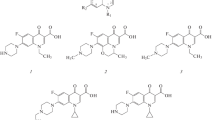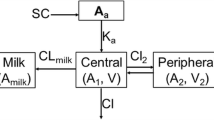Summary
10 healthy lactating women were treated orally with the anthelmintic praziquantel (Biltricide ®), and the resulting timedependent concentrations of the unchanged substance in plasma and milk were determined simultaneously. 5 of the women (“1st trial”) received the single dose of 50 mg/kg; the other 5 women (“2nd trial”) were treated three times at 4 hour intervals with 20 mg/kg. p ]During the 1st trial a maximal plasma-concentration of 1.30 mg/1 (arithmetic mean) was found. Subsequently the mean plasma-concentration decreased continuously and after 24 h it was only 0.4% of the maximum. During the 2nd trial the highest mean value (1.92 mg/1) was found 10 h after the first administration; after 32 h (24 h after the last administration) the mean value was 0.6% of the maximum mean value. The mean areas under the concentration/time-curves were 5.25 h·mg/l and 13.8 h·mg/l, respectively. The plasma half-life was estimated to be 3 hours.
In both trials the concentration/time-curves of the milk corresponded qualitatively to those of the plasma. However, in each person and at each time, the concentration in the milk were essentially lower than those in the plasma. On the average, the plasma-concentrations were four times higher than the milk-concentrations. The mean values of the milk-concentrations increased and decreased correspondingly with those of the plasma-concentrations. At the end of the investigation (24 and 32 h, respectively, from the beginning) they were lower than the limit of determination (4 μg/1). The mean excretion with the milk of the 10 women was 0.0008% of the given dose.
From the comparative concentration/time-course, it could be demonstrated that the milk does not represent a deep department but readily equilibrates with the plasma. Equilibration obviously takes place by passive diffusion and not by active secretion.
Similar content being viewed by others
References
Diekmann H.W. (1979): Quantitative determination of praziquantel in body fluids by gas liquid chromatography, Europ. J. Drug. Met. Pharmacokin.,4, 139–141.
Pütter J. (1979): Fluorometric method for the determination of praziquantel in blood plasma and urine, Europ. J. Drug. Met. Pharmacokin.,4, 143–148.
Patzschke K., Pütter J., Wegner L.A., Horster F.A., Diekmann H.W. (1979): Serum concentrations and renal excretion after oral administration of praziquantel — results of three determination methods, Europ. J. Drug Met. Pharmacokin.,4, 149–156.
Leopold G., Ungethüm W., Groll E., Diekmann H.W., Nowak H., Wegner D.H.G. (1978): Clinical pharmacology in normal volunteers of praziquantel, a new drug against schistosomas and cestodes, Europ. J. Clin. Pharmacol.,14, 281–291.
Bühring K.V., Diekmann H.W., Müller H., Gerbe A., Nowak H. (1978): Metabolism of praziquantel in man, Europ. J. Drug Met. Pharmacokin.,3, 179–190.
Author information
Authors and Affiliations
Additional information
® registered trade-mark of BAYER AG/Leverkusen.
Rights and permissions
About this article
Cite this article
PÜtter, J., Held, F. Quantitative studies on the occurence of praziquantel in milk and plasma of lactating women. European Journal of Drug Metabolism and Pharmacokinetics 4, 193–198 (1979). https://doi.org/10.1007/BF03189426
Received:
Issue Date:
DOI: https://doi.org/10.1007/BF03189426




